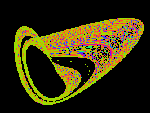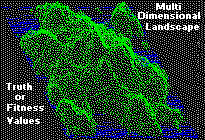"A violent order is disorder; and a great disorder is an order.
These two things are one."Wallace Stevens, Connoisseur of Chaos, 1942
"Curiously, the unexpected complexity that has been discovered in nature has not led to a slowdown in the progress of science, but on the contrary to the emergence of new conceptual structures that now appear as essential to our understanding of the physical world - the world that includes us."Ilya Prigogine & Isabelle Stengers, Order Out Of Chaos, 1985, Introduction
One of the main themes within the field of Complex Systems theory is in what circumstances order can result from the random interactions of multiple agents. In order to understand this, we shall introduce the concept of an attractor, look at attractor basins and identify the forms of order we encounter. We also look at fitness landscapes and co-evolution, state space, evolution and mental categories.
A useful insight into the possibilities here can be gained by considering the concept of basins of attraction. Let us start by thinking of a bowl containing a ball bearing. This will move around the bowl until eventually it comes to rest at the lowest point. We can say that it is 'attracted' to that point, so each part of the bowl can be regarded as leading to that stationary point, and the whole bowl is what we call the basin of attraction of that system. If we place the ball bearing outside the bowl then it will have a tendency to go somewhere else, so we can see that an attractor is only effective within a certain area of space, and we can have many different attractors adjoining each other.
 For any dynamic (time changing) system the attractor is where it will end up eventually.
Now this need not be a fixed equilibrium point like we saw above, we can have
attractors that follow an orbit (like that of the planets round the sun) or we may have
a system that never returns to the same place - this we call a 'Strange Attractor'.
The Lorenz and Rossler (shown) attractors are important examples of this type of chaotic system.
For any dynamic (time changing) system the attractor is where it will end up eventually.
Now this need not be a fixed equilibrium point like we saw above, we can have
attractors that follow an orbit (like that of the planets round the sun) or we may have
a system that never returns to the same place - this we call a 'Strange Attractor'.
The Lorenz and Rossler (shown) attractors are important examples of this type of chaotic system.
Let us now take a golf putting green. Imagine a player trying to get the ball in the hole. The hole is an attractor too. But it will only work as such if the ball gets close enough to the rim. Before we get there we have to negotiate the surface between the player and the hole and that has many other local attractors and barriers (little holes, ridges etc.).
Each ridge is a point of decision, the ball can fall to one side or the other, which path it takes is extremely dependent on initial conditions. A very minor change can switch the path from one attractor - the hole, to a nearby one - missed ! Once this bifurcation point has been passed it may take a very large perturbation (a hidden stone say) to switch attractors again, we say the system has become 'locked' into a particular attractor.
Can we apply these ideas to people issues ? Indeed we can, we are all familiar with decisions that once made are difficult to reverse, and also perhaps with the feeling that we are being drawn into a situation against our will. Consider life then as a complex landscape full of hills and valleys. We try to navigate from attractor to attractor, using energy to climb to the top of a nearby hill - changing state, so that we can reach a better valley, a new (hopefully more rewarding) steady state - or attractor. There seems to be only one problem. We can see neither the hills nor the valleys and don't know if we are getting higher or lower on our personal quest. So how is this landscape structured ?
Let me introduce the concept of 'State Space', also called 'Phase Space'. This is simply an imaginary map of all the possibilities open to the system, e.g. for a coin toss it is just two points, heads or tails. For a bigger example let's take a computer screen, mine has a matrix of 640 dots horizontally and 480 dots vertically. Each of these can be one of 256 colours, so the total possible different arrangements we can obtain is 256 to the power 307200 (256307200) - rather a lot for such a simple example ! In this vast state space each point represents the computer screen being in a specific state (and so uniquely defines the state of all the 640x480 dots on the display). As the screen changes a succession of points in state space are invoked, the sequence of these activations is the time trajectory of the system in state space.
If our computer has, say, a tendency to make the screen go blank then every trajectory will eventually end up at the same point, that single state space point corresponding to a totally blank screen, in other words a 'Point' attractor. If instead the screen cycles between several states in a regular fashion we will have a loop in state space - a 'Periodic' attractor, and if a random pattern appears we may have more exotic trajectories in state space - perhaps 'Strange' or 'Ergodic' attractors. We can have order in state space even if normal space appears chaotic.
We can generalise this idea to any more complex system, but to avoid confusion it is useful to consider only up to 3 dimensions (degrees of freedom in the jargon) at a time. In Evolutionary Theory we often define a 'Fitness Landscape' which substitutes fitness for the colour in our example, and takes two chosen parameters (variations) for the axes.
 Let us suppose one variable is environmental temperature, and the other is the type of cell
chemistry. Our own metabolism works best within a very narrow range of temperature, so we have a fitness
peak at a point in space corresponding to our cell chemistry and the optimum temperature. Other forms
of chemistry may work best at different temperatures, so the landscape will have other peaks corresponding
to those combinations. The shape of those hills may be different to ours, more or less steep, higher or lower
peaks (the definitions are somewhat arbitrary as to how we measure fitness), but all the hills correspond to
Evolutionary Stable Systems (ESSs), in other words attractors.
Let us suppose one variable is environmental temperature, and the other is the type of cell
chemistry. Our own metabolism works best within a very narrow range of temperature, so we have a fitness
peak at a point in space corresponding to our cell chemistry and the optimum temperature. Other forms
of chemistry may work best at different temperatures, so the landscape will have other peaks corresponding
to those combinations. The shape of those hills may be different to ours, more or less steep, higher or lower
peaks (the definitions are somewhat arbitrary as to how we measure fitness), but all the hills correspond to
Evolutionary Stable Systems (ESSs), in other words attractors.
How does evolution work ? Well, we have random variations in the parameters (mutations). If the variation gives an increase in fitness the organism works better and natural selection will favour those variations for later generations - we climb the hill, increasing our adaptation to the environment. Random changes here lead to adaptive order. But once on a peak we are stuck are we not ?
Yes and no. We are assuming as yet that the peaks are fixed, that they never change. That is rarely the case for reasons we will discuss next, but nature has another solution here - sex ! Mating effectively shuffles the parameters, we are shifted across the landscape to a new point at random, a leap rather than a crawl. If a higher peak is nearby, this crossover (or recombination) can jump across the valley and establish a beachhead on the new hill. We can then 'hill climb' that peak subsequently towards a better future. We may of course land in the bottom of an even lower valley, most do and die out - failed experiments. Nature can be cruel...
But we said the landscape changes, how ? Creatures do not only optimise themselves against the environment (which changes slowly, if at all) but against other creatures also - they compete and cooperate. A predator will evolve better eyesight to see its prey, but the prey will evolve a disguise, negating the eyesight advantage - the peak the predator attempted to climb has moved from under its feet, the fitness peak has shifted, the landscape has deformed due to the changes in the prey. This 'Coevolution' means that the fitness landscape seen by one creature is a dynamic, ever changing map dependent upon the actions of everything else in its surroundings. This is true for all the occupants of an ecosystem. It is a highly non-linear, closely coupled system - attractors that vary in both shape and position over time.
Can we extend these ideas to the human mind ? I think we can. Imagine seeing a table, how did you recognise it ? It is I think useful to think of our mental categories as forms of attractor, we have thus a large number of resident attractors, one for each concept we have. When we see a scene we extract various features from it and try to identify them. If we allow that they follow a trajectory towards the strongest attractor then we have a natural way of explaining why we think of one thing and not another - its starting point was in the basin of attraction of that particular idea. The mind's state space is a complex multi-dimensional matrix of many parameters, one for each feature of the scene. Thus the starting point for any scene is likely to be unique, and the path taken also will be impossible to predict. A minor perturbation (a memory, a change of light say) can be sufficient to switch to a different attractor - we have an alternative transient thought or image. From what we have said about coevolution, we can see that changes to the component parts can change the shape of the landscape and thus the attractors (categories) that make it up. Taking drugs, alcohol or medicines are perturbations of this sort, as are invasions by pathogens. This could explain, I suspect, the changes to perception that take place in those circumstances - a switch to an alternative state of consciousness.
The formation of these mental attractors, if such there are, and their changes with learning is an interesting problem in developmental or Evolutionary Psychology.